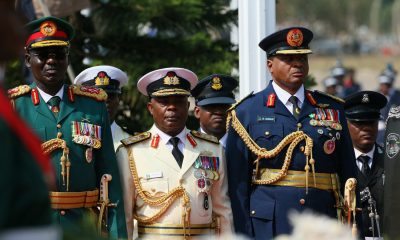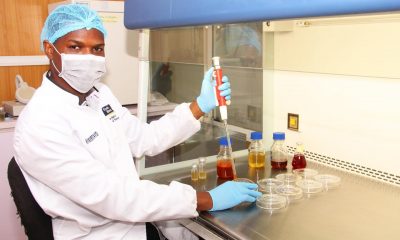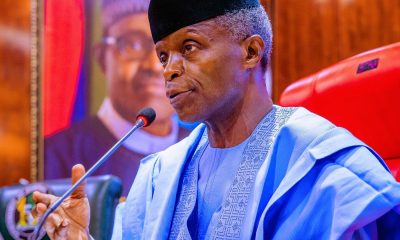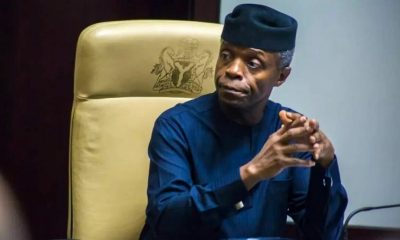General
Osinbajo Tasks Military to Partner Private Sector on Research, Innovation
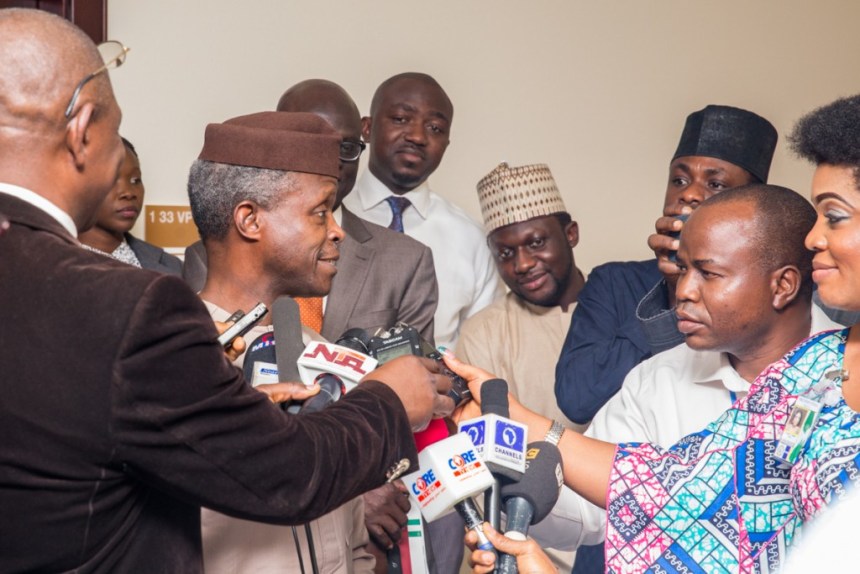
By Modupe Gbadeyanka
Vice President, Mr Yemi Osinbajo, has advised the Nigerian Armed Forces to partner with the private sector on research and innovation.
Mr Osinbajo gave this charge at the weekend during the combined passing out parade for cadets of 64 Regular Course (Army, Navy, Air Force) 65 Regular Course (Navy and Air Force) and Short Service Course 44 (Army) where he represented President Muhammadu Buhari.
The Vice President said crimes in the world have taken new turns and security operatives have to always be a step ahead of criminals, especially terrorists.
He said last week’s bombing in a London tube suggest that tutorials for making the explosive devices used are available on the internet.
“How can the military get ahead of the curve on communications in the age of the fast, cheap and available communication for all?” he asked, pointing out that, “We must also answer the question of how to defeat the ideologies that promote mindless killings and anarchy.”
He further said the swift evolution in suicide bombings is a perfect illustration of the nature of the threats that nations face today, unpredictable, asymmetric, constantly adapting to changing conditions, driven by a compulsive need to inflict maximum damage with minimal effort.
According to him, “This is therefore the question we ought to be asking ourselves: Are our Armed Forces evolving with a similar speed and urgency, are they adapting with a similar nimbleness? How do we evolve rules of engagement in asymmetric warfare situations? Should we be redefining the borders of the Geneva Convention in the light of military engagements with armed militant combatants? Can we observe the same human rights rules where suicide bombers and persons determined to die and take with them as many innocent lives as possible are the enemy we must confront? What are the borders of the right to privacy and freedom of expression on the internet? What is the responsibility of Nations of the world in policing the internet which has become a virtual training ground for much good and as much evil?”
Mr Osinbajo said, “But just as important as these issues around conflict are the issues around how the military can in the process of innovating or thinking through use science and technology to add real value to the society and nation it has sworn to defend.”
“Let me speak briefly about the relationship between the military and scientific innovation, and how both have historically shaped and influenced each other.
“Centuries ago, inventions like the wheel, and gunpowder, forever changed the nature of war. National armies wasted little time taking advantage of these innovations in the endless battle to gain an edge over existing and emerging enemies.
“In a similar manner, the military has also spearheaded technology and practices that civilians have latched on to, to alter human civilization as we know it. The one that comes to mind most readily is the Internet, originating from the 1960s Advanced Research Projects Agency Network (ARPANET) Project of the United States Department of Defense.
“Five decades on, the Internet has turned out to be perhaps the most definitive invention in the history of mankind, creating unprecedented social, economic and political opportunity. The American military has also been credited with the invention of GPS- Global Positioning System (GPS) now so common that every smartphone and cars use it to ascertain location.
“But this network of satellites was originally set up by the U.S. Department of Defense in the 1970s. President Ronald Reagan ordered GPS to be made available to civilians once it was completed, while President Bill Clinton later declared that the highest quality GPS signal should be available as well.
“How about RADAR? (an acronym for Radio Detection and Ranging,) this system uses radio waves to find speed, altitude, range, and direction of moving objects such as planes, ground vehicles, missiles, etc. Radar was developed before World War II for military purposes.
“Today, it’s used for a variety of purposes, both military and civilian, including air traffic control and weather forecasting. Inadvertently, it was discovered that microwaves transmitted from radar equipment during WWII could also cook food, which led to the post-war creation of the microwave oven.
“The use of Unmanned Aerial devices or drones today for surveillance, photography (and in Rwanda), the delivery of blood to rural medical facilities originated from the development of the devices by the military in the early 20th Century.
“The world I have just described is the one that today’s cadets are graduating into. Placed side-by-side with this contemporary context, the Cold War Era into which your predecessors – today’s Generals and Commanding Officers – graduated, almost feels like a model of orderliness and predictability.
“At this point let me say that I am pleased to note that the NDA has been positioning itself as a hub for innovation. I am already aware of inventions such as an Automated Pop-Up Target System, a Multi-Purpose Combat Mobile Robot, and a Perimeter Surveillance Robot, which the NDA has showcased at various science and technology exhibitions in the recent past. This is laudable and I urge you to sustain the culture.
“I would also like to urge you to collaborate more extensively with the private sector, for research and innovation. All around the country technology hubs are springing up that are attracting our Nigeria’s brightest talent, and breaking new technological ground. I am convinced that the military should make its presence felt in this area,” the Vice President said.
General
Christmas: Tinubu Calls for Religious Tolerance Amid Rising Insecurity
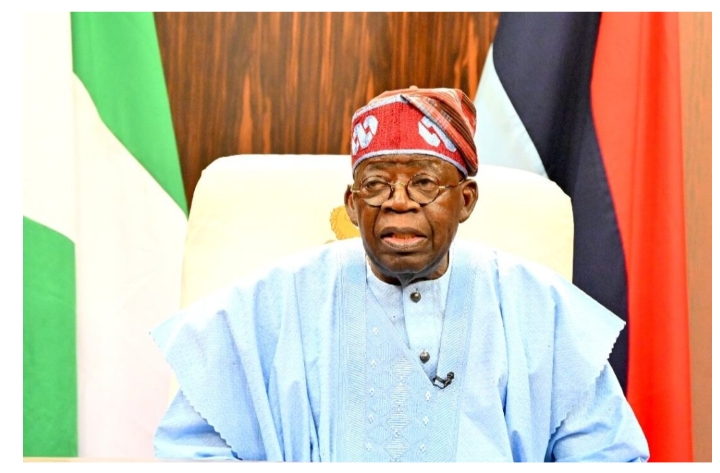
By Adedapo Adesanya
President Bola Tinubu has called on Nigerians to embrace religious tolerance, peace, and unity, urging citizens of all faiths to reject violence and intolerance amid ongoing security challenges across the country.
In his 2025 Christmas goodwill message issued on Wednesday by his Special Adviser on Information and Strategy, Mr Mr Bayo Onanuga, the President emphasised that no Nigerian should suffer discrimination or violence because of their religious beliefs, reaffirming his administration’s commitment to safeguarding freedom of worship and national cohesion.
“As your President, I remain committed to doing everything within my power to enshrine religious freedom in Nigeria and to protect all people of different faiths from violence,” Mr Tinubu said, noting that all Nigerians have the constitutional right to live, worship, and pursue their aspirations in safety and dignity.
The President acknowledged growing concerns around religious intolerance and insecurity, revealing that he had engaged extensively throughout the year with leaders of Nigeria’s two major faiths.
In the last few months, the country faced a spate of attacks including kidnapping of school children and armed terror, involving the death of a high ranking army personnel.
He also said the government would continue to build on these engagements to strengthen collaboration with religious institutions, prevent conflict, and promote peaceful coexistence.
President Tinubu described Christmas as a period for reflection on the message of Jesus Christ as the Prince of Peace, urging Nigerians to draw inspiration from values of love, compassion, and goodwill that cut across all major religions.
He commended Christians in Nigeria for their contributions to national development, particularly their role in caring for the vulnerable and promoting harmony within communities.
“The love for God and love for humanity is at the heart of all the great faiths. These shared values must continue to bind us together as one indivisible and resilient people,” he said.
Reiterating his administration’s stance on security, the President said the government’s commitment to protecting Nigeria’s unity and stability has remained unwavering since he assumed office in 2023. He stressed that the state would not tolerate violence targeted at any group on the basis of ethnicity or belief.
President Tinubu also appealed to Nigerians travelling during the festive season to exercise patience and discipline on the roads, wishing them safe journeys and returns.
Expressing optimism about the country’s future, the President said that with faith in God and collective resolve, Nigeria would overcome its challenges and build a nation that future generations would be proud of.
He concluded by wishing Christians in Nigeria and around the world a Merry Christmas and Nigerians a happy New Year in advance.
General
FG Slams 16 Money Laundering Charges of N1.014bn Against Malami
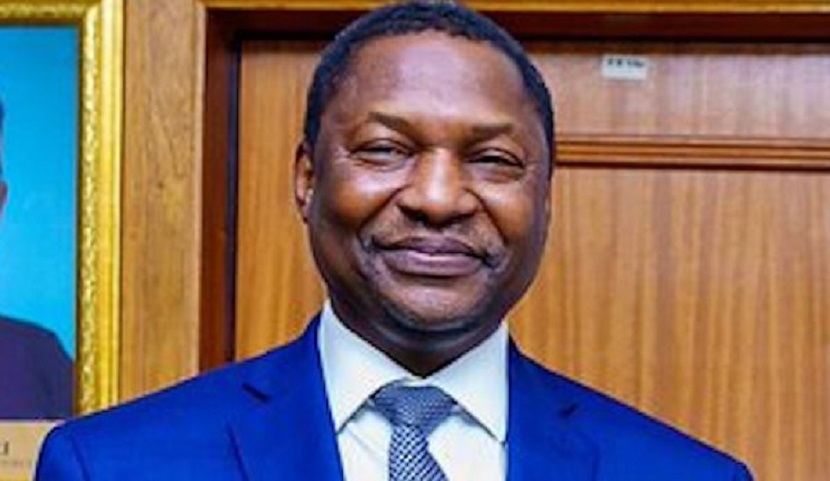
By Adedapo Adesanya
The federal government has filed 16 alleged money laundering charges, to the tune of N1.014 billion, against a former Attorney-General of the Federation and Minister of Justice, Mr Abubakar Malami (SAN), and his son, Mr Abubakar Abdulaziz Malami, before the Federal High Court in Abuja.
Also listed as a co-defendant in the case is Hajia Bashir Asabe.
According to the charge, the government is accusing Mr Malami, his son, and others of being involved in the laundering and concealment of N1,014,848,500.00 allegedly traced to a commercial bank.
In the 16 charges, the Nigerian government alleged that between July 2022 and June 2025, within Abuja and the jurisdiction of the court, the defendants procured Metropolitan Auto Tech Limited to conceal the unlawful origin of the money.
The charge alleges, in part, that the defendants used the company as a front to conceal the origin and movement of the funds, an act the government says constitutes money laundering under Nigerian law.
The alleged offence is said to be contrary to Section 21(c) of the Money Laundering (Prevention and Prohibition) Act, 2022, and punishable under Section 18(3) of the same Act.
The 16 charges reveal how Malami allegedly engaged Metropolitan Auto Tech Limited to launder funds.
The charges are as follows:
“That you Abubakar Malami SAN, and Abubakar Abdulaziz Malami between July 2022 and June, 2025 in Abuja within the jurisdiction of this Honourable Court did procure Metropolitan Auto Tech Limited to conceal the unlawful origin of the total sum of N1, 014, 848, 500.00 (One Billion, Fourteen Million, Eight Hundred and Forty Eight Thousand, Five Hundred Naira) in the Sterling Bank Plc Account No. 0079182387 when you reasonably ought to have known that the said sum formed proceeds of unlawful activities and you thereby committed an offence contrary to Section 21(c) of the Money Laundering (Prevention and Prohibition) Act 2022 and punishable under Section 18(3) of the same Act.
“That you Abubakar Malami SAN whilst being the Attorney-General of the Federation, and Abubakar Abdulaziz Malami between September 2020 and February, 2021in Abuja within the jurisdiction of this Honourable Court did procure Metropolitan Auto Tech Limited to conceal the unlawful origin of the total sum of N600,013,460.4 in the Sterling Bank Plc Account No. 0079182387 when you reasonably ought to have known that the said sum formed proceeds of unlawful activities and you thereby committed an offence contrary to Section 18(c) of the Money Laundering Prohibition Act 2011 as amended by Act No. 1 of 2012) and punishable under section 15(3) of the same Act
“That you Abubakar Malami SAN whilst being the Attorney-General of the Federation and Abubakar Abdulaziz Malami sometime in March, 2021 in Abuja within the jurisdiction of this Honourable Court did retain the total sum of N600,000,000.00 in Metropolitan Auto Tech Limited as cash collateral for a loan of N500,000,000.00 granted to RAYHAAN HOTELS LTD by Sterling Bank Plc when you reasonably ought to have known that the said cash collateral of N600,000,000.00 was proceed of unlawful activities and you thereby committed an offence contrary to Section 18(c) of the Money Laundering Prohibition Act 2011 as amendedpunishable under section 15(3) of the same Act
“That you Abubakar Malami SAN whilst being the Attorney-General of the Federation, Abubakar Abdulaziz Malami, and Hajia Bashir Asabe an employee of Rahamaniyya Properties Limited sometime in November, 2022 in Abuja within the jurisdiction of this Honourable Court did indirectly disguise the unlawful origin of the aggregate sum of N500,000,000.00 paid to Efab Properties Ltd paid for purchase of property known as luxury duplex at Amazon street, Plot No. 3011 within Cadastral Zone A06 Maitama District, Abuja in favour of Abubakar Malami SAN when you reasonably ought to have known that the said N500million formed proceed of unlawful activity and you thereby committed an offence contrary to section 18(2) (a) and punishable under section 18(3) of the Money Laundering (Prevention and Prohibition) Act, 2022.
“That you Abubakar Malami SAN, Abubakar Abdulaziz Malami, and Hajia Bashir Asabe an employee of Rahamaniyya Properties Ltd sometimes in September 2024 in Abuja within the jurisdiction of this Honourable Court conspired to disguise the unlawful origin of the aggregate sum of N1,049,173,926.13 paid through the Union Bank Plc account of Meethaq Hotels Ltd Jabi savings Account No. 0179011105 between November 2022 and September 2024 and you thereby committed an offence contrary to Section 21 of the Money Laundering (Prevention and Prohibition Act) 2022 and punishable under Section 18(2) (a) and (3) of the same Act.
“That you Abubakar Malami SAN, and Abubakar Abdulaziz Malami between November 2022 and October, 2025 indirectly took control of the aggregate sum of N1,362,887,872.96 paid through the savings account of Meethaq Hotels Limited in Union Bank Plc when you reasonably ought to have known that the said funds formed proceeds of unlawful activity and you thereby committed an offence contrary to Section 18(2) (d) and punishable under Section 18(3) of the Money Laundering (Prevention and Prohibition) Act, 2022.
“That you Abubakar Malami SAN whilst being the Attorney-General of the Federation and Hajia Bashir Asabe an employee of Rahamaniyya Properties Ltd sometimes between November and December, 2018 in Abuja within the jurisdiction of this Honourable Court indirectly concealed the unlawful origin of the aggregate sum of N700,000,000.00 paid for the purchase of the property described as No. 3 Onitsha Crescent Area 11, Garki Abuja (Hamonia Hotels Ltd) in favour of Abubakar Malami SAN when you reasonably ought to have known that the said sum of N700, 000,000.00formed proceeds of unlawful activityand you thereby committed an offence contrary to section 15(2) (d) and punishable under section 15(3) of the Money Laundering (Prohibition) Act, 2011 as amended.
“That you Abubakar Malami SAN whilst being the Attorney-General of the Federation, Abubakar Abdulaziz Malami and Hajia Bashir Asabe an employee of Rahamaniyya Properties Ltdsometimes between September 2020 and December, 2020 in Abuja within the jurisdiction of this Honourable Court, indirectly concealed the aggregate sum of N850,000,000.00 paid for the purchase of property described as Plot 683 Jabi District Cadastral Zone B04 (Meethaq Hotels Ltd, Jabi) when you reasonably ought to have known that the said sum of N850, 000, 000.00 represented proceeds of unlawful activity and you thereby committed an offence contrary to Section 15(2) (d) and punishable under Section 15(3) of the Money Laundering (Prohibition) Act, 2011 as amended.
“That you Abubakar Malami SAN whilst being the Attorney-General of the Federation and Hajia Bashir Asabe an employee of Rahamaniyya Properties Limited on or about February, 2018 in Abuja within the jurisdiction of this Honourable Court indirectly acquired the property described as No. 3 Rhine Street Maitama, Abuja (Meethaq Hotels Ltd) for an aggregate sum of N430,000,000.00 when you reasonably ought to have known that the said sum of N430,000,000.00 formed proceeds of unlawful activity and you thereby committed an offence contrary to Section 15(2) (d) and punishable under Section 15(3) of the Money Laundering (Prohibition) Act, 2011 as amended.”
“That you Abubakar Malami SAN whilst being the Attorney-General of the Federation and Hajia Bashir Asabe an employee of Rahamaniyya Properties Ltd sometimes on or about February, 2018 in Abuja within the jurisdiction of this Honourable Court indirectly concealed the unlawful origin of the aggregate sum of N210,000,000.00 paid for the purchaseof the property described as No. 3130 Cadastral Zone A04 Asokoro District, Abuja in favour of Abubakar Malami SAN when you reasonably ought to have known that the said sum of N210, 000, 000,000.00 represented proceeds of unlawful activity and you thereby committed an offence contrary to section 15(2) (d) and punishable under Section 15(3) of the Money Laundering ( Prohibition) Act, 2011 as amended.
“That you Abubakar Malami SAN whilst being the Attorney-General of the Federation and Hajia Bashir Asabe an employee of Rahamaniyya Properties Ltd between March and June 2021 in Abuja within the jurisdiction of this Honourable Court indirectly concealed the unlawful origin of the aggregate sum of N325,000,000,000.00 paid for the purchase of property described as No. 1241B Asokoro District Zone (No. 11A Yakubu Gowon Crescent Asokoro) in favour of Abubakar Malami SAN when you reasonably ought to have known that the said sum of N325, 000, 000.00 represented proceed of unlawful activity and you thereby committed an offence contrary to section 15(2) (d) and punishable under section 15(3) of the Money Laundering ( Prohibition) Act, 2011 as amended.
“That you Abubakar Malami SAN whilst being the Attorney-General of the Federation and Hajia Bashir Asabe an employee of Rahamaniyya Properties Ltd between November 2015 and January, 2016 in Abuja within the jurisdiction of this Honourable Court indirectly concealed the unlawful origin of the aggregate sum of N120,000,000,000.00 paid for the purchase of property described as No. 27 Efab Estate 5th Avenue, 59th Crescent, Gwarimpa, Abuja in favour of Abubakar Malami SAN when you reasonably ought to have known that the said sum of N120, 000, 000.00 represented proceeds of unlawful activity and you thereby committed an offence contrary to section 15(2) (d) and punishable under section 15(3) of the Money Laundering ( Prohibition) Act, 2011 as amended.
“That you Abubakar Malami SANwhilst being the Attorney-General of the Federation, Abubakar Abdulaziz Malami, and Hajia Bashir Asabe an employee of Rahamaniyya Properties Ltd sometime in November, 2022 in Abuja within the jurisdiction of this Honourable Court did conspire amongst yourselves to conceal the unlawful origin of the funds paid for the purchase of property known as luxury duplex at Amazon street, Plot No. 3011 within Cadastral Zone A06 Maitama District, Abuja and you thereby committed an offence contrary to Section 21 of the Money Laundering (Prevention and Prohibition Act) 2022 and punishable under Section 18(2) (a) and (3) of the same Act.
“That you Abubakar Malami SAN whilst being the Attorney-General of the Federation, Hajia Bashir Asabe whilst being an employee of Rahamaniyya Properties Ltd and other persons at large between December, 2016 and April, 2022 in Abuja within the jurisdiction of this Honourable Court conspired amongst yourselves to indirectly acquire landed properties for Abubakar Malami SAN with proceeds of unlawful activity and you thereby committed an offence contrary to section 18 of the Money Laundering (Prohibition Act) 2011 and punishable under Section 15(2) (a) and (3) of the same Act.
“That you Abubakar Malami SAN whilst being the Attorney-General of the Federation, between June and January, 2023in Abuja within the jurisdiction of this Honourable Court indirectly concealed the unlawful origin of the aggregate sum N537,000,000.00 which you paid for the purchase of the properties namely (i) No. 26 Babbi Street, BUA Estate, Abuja, (ii) 4 bedroom Bungalow, Guesse 2 Brinin- Kebbi and (iii) No. 4 Ahmadu Bello Way, Kano, Nassarawa GRA, Kano knowing that the said sum of N537, 000,000.00formed proceeds of unlawful activity and you thereby committed an offence contrary to section 18(2) (a) and punishable under section 18(3) of the Money Laundering (Prevention and Prohibition) Act, 2022.
“That you Abubakar Malami SAN whilst being the Attorney-General of the Federation, between October 2018 and December, 2021 in Abuja within the jurisdiction of this Honourable Court indirectly concealed the aggregate sum N415,000,000.00 which you paid for the purchase of the properties namely (i) No. 28 Bagudu Kaltio crescent Gwarimpa, Abuja (ii) Plot 13, Ipent 7 Estate Abuja and (iii) A Plaza, Commercial Toilets, Laundry and Warehouse Tanks Adjacent to Brinin Kebbi Market (iv) 100 hectares of land Along Brinin Kebbi, Jeba Road (v) Plot 157 Lamido Crescent, Nassarawa Road GRA, Kano knowing that the said sum of N415,000,000.00 formed proceeds of unlawful activity and you thereby committed an offence contrary to Section 15(2) (a) and punishable under Section 15(3) of the Money Laundering Prohibition Act, 2011 as amended.”
Mr Malami served as Attorney-General and Minister of Justice from 2015 to 2023 under the administration of former President Muhammadu Buhari.
General
KWAM 1 Ends Awujale Ambition, Withdraws Legal Challenge
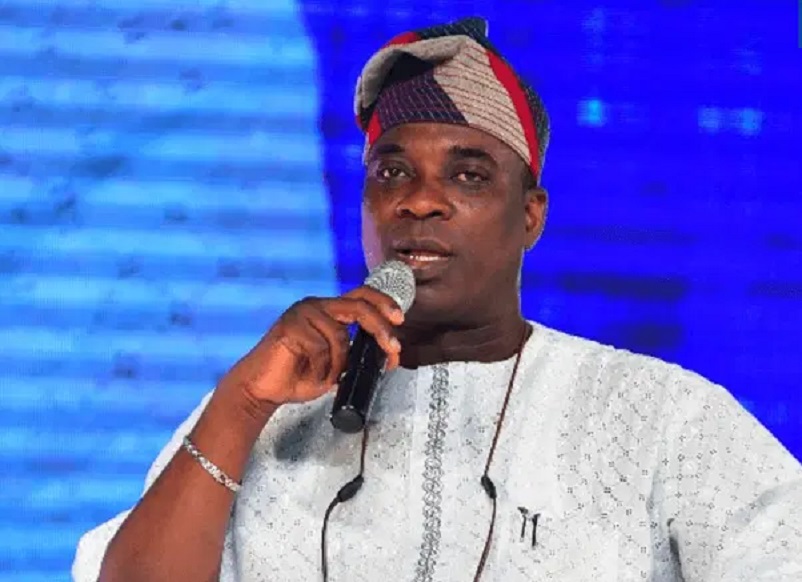
By Adedapo Adesanya
Fuji musician, Mr Wasiu Ayinde, popularly known as K1 De Ultimate or KWAM 1, has formally withdrawn from the race for the Awujale of Ijebuland after staunch opposition to his ambitions.
This came as the minstrel filed a notice of discontinuation at the Ogun State High Court to end his legal challenge against the ongoing selection process.
The notice, filed on Monday, December 22, 2025, by his legal team led by Mr Wahab Shittu (SAN), brings to a close his controversial bid for the revered throne.
The withdrawal followed a ruling by Justice A. A. Omoniyi of High Court 3, Ijebu-Ode Judicial Division, who dismissed KWAM 1’s application for an interim injunction seeking to restrain the Ogun State Governor, Mr Dapo Abiodun, the Fusengbuwa Ruling House and other parties from proceeding with the selection of a new Awujale.
Justice Omoniyi held that the application lacked merit but ruled that the substantive suit could proceed on its merits, fixing January 14, 2026, for further hearing.
KWAM 1, the Olori Omooba of Ijebuland from the Fidipote Ruling House, had approached the court after the Fusengbuwa Ruling House declared him ineligible to contest for the stool, insisting he was not a bona fide member of the ruling house and therefore could not vie for the throne under its platform.
However, with the filing of the notice of discontinuation, KWAM 1 appears to have formally recused himself from the Awujale selection process, effectively ending his challenge.
He joined as respondents in the case: the Ogun State Governor, the Commissioner for Local Government and Chieftaincy Affairs, the Attorney General and Commissioner for Justice, the Secretary of Ijebu-Ode Local Government, the Chairman of the Awujale Interregnum Administrative Council, and the Chairman of the Fusengbuwa Ruling House.
In the application, KWAM 1 contended that he is a bonafide member of both the Fusengbuwa and Fidipote ruling houses, and that his rights as a potential candidate were being threatened by what he described as a flawed and unlawful process.
He alleged that the Awujale Interregnum Administrative Council, which he described as an “unrecognised body”, was exerting influence over the nomination procedure in violation of Ogun State chieftaincy laws.
Central to his claim was the argument that due process was not followed, particularly the requirement that the Ijebu-Ode Local Government formally publish the names of the 13 recognised kingmakers before any selection exercise commences.
KWAM 1 maintained that the failure to comply with this step rendered the process vulnerable to legal challenge.
The suit was filed against the backdrop of the vacancy created by the death of Oba Sikiru Kayode Adetona in July, at the age of 91, after a reign of more than six decades.
-

 Feature/OPED6 years ago
Feature/OPED6 years agoDavos was Different this year
-
Travel/Tourism9 years ago
Lagos Seals Western Lodge Hotel In Ikorodu
-

 Showbiz3 years ago
Showbiz3 years agoEstranged Lover Releases Videos of Empress Njamah Bathing
-

 Banking8 years ago
Banking8 years agoSort Codes of GTBank Branches in Nigeria
-

 Economy3 years ago
Economy3 years agoSubsidy Removal: CNG at N130 Per Litre Cheaper Than Petrol—IPMAN
-

 Banking3 years ago
Banking3 years agoFirst Bank Announces Planned Downtime
-

 Banking3 years ago
Banking3 years agoSort Codes of UBA Branches in Nigeria
-

 Sports3 years ago
Sports3 years agoHighest Paid Nigerian Footballer – How Much Do Nigerian Footballers Earn



